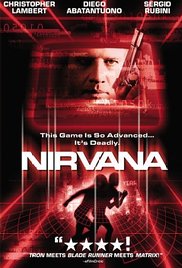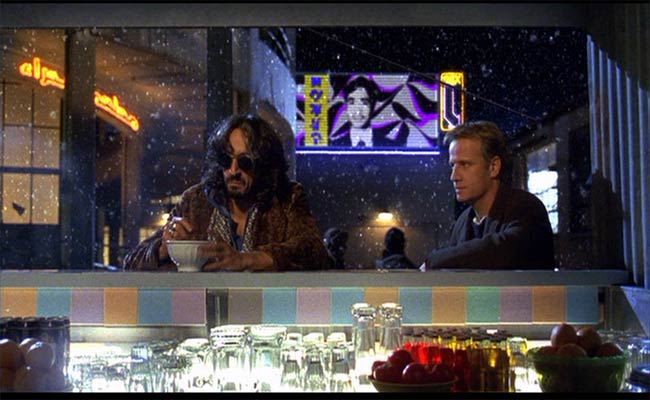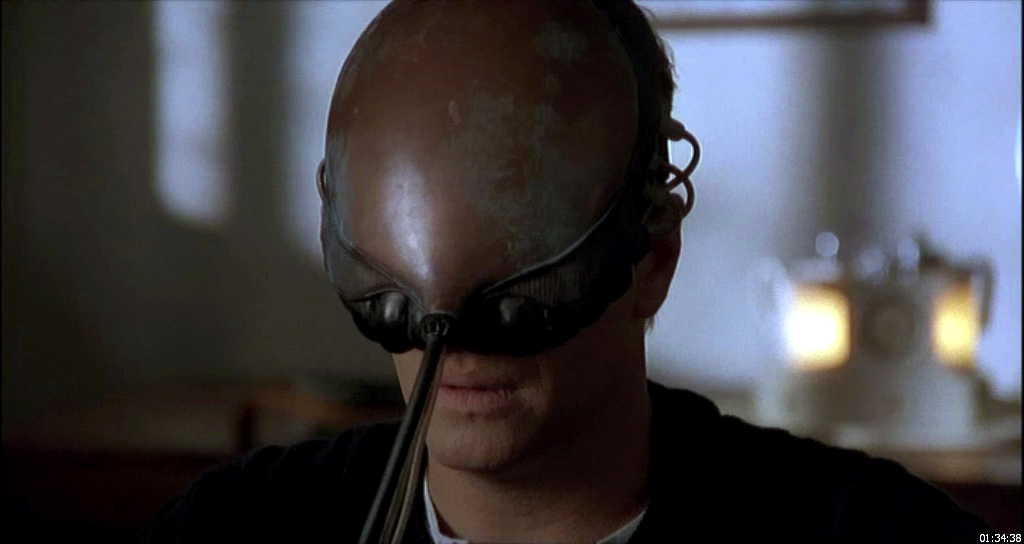Nirvana:

A Poster for Nirvana by Gabriele Salvatores and starring Christopher Lambert
In terms of commercial success the film that has done the best in the realm of science fiction in Italy is that of Nirvana directed by Gabriele Salvatores and starring Christopher Lambert. The film has heavy influences in setting to that of both Blade Runner and other 80’s style science fiction films like Total Recall. The environments are run down and many neon signs light the cityscapes. The film opens with an image of a woman, who would come to play a large role later, talking to an unknown man named Jimi. It then cuts to another character who we learn is named Solo. He has no recollection of who he is or where he came from. Solo however is shot by what appears to be a gangster of some sort and it cuts to that of Jimi, who was referenced earlier by the woman. It is a quick, consise introduction that sets up the premise well. The audience is already left questioning what it is they just saw and how long will it take for it to be explained. However, it is of note that a certain amount of artistry went into introducing all three charachters as they were all filmed in a different fashion. The scenes with the woman are blurred or pixelated as to indicate a disconnection of some sort. Then the scenes with Solo are black and white for the most part however some of the objects in the world are glowing vibrant colors to make a feel very similar to that of the little girl in that of Schindler’s list. It is a highly contrasting world that has an almost unfinished look to it or almost artificial.
Above video clips show the unique perpectives of both Solo(Left) and the mystery woman(Right)
The plot of the film is fairly typical science fiction affair. We learn that Jimi is an experienced programmer who developed a game, called Nirvana and hence the title of the film, for a mega corporation. He talks to his artificial intelligence early on in the film and it is revealed through that discussion that he has only three days to deliver this game to the company. This dialogue is interrupted however by a man that knocks on the door to his apartment. He is a cab driver, but also a drug dealer, who is offering Jimi liquid marijuana and through this discussion we first get a sense of the world we are watching. It is the first scene where the divide between rich and poor comes up in the film. The cab driver reveals that he is always willing to make money because he wants to live very much like Jimi some day. Apparently in this world the rich are comforted in luxury while the middle and poor class people live in the slums of the cities.
Above video clip shows setting. Note the neon lights and busy streets
The main conflict however then developes when Jimi figures out that his game has a virus and it gives the charachter of his game artificial intelligence. That charachter is revealed to be Solo who is forced to relive the same experiences over and over again and each time he dies he resets. Every time that he does die he remembers the previous “Lifes” scenario. He pleads with Jimi to delete him and then Jimi, realizing that it is impossible until he removes the copy in the company server, embarks to find a man named Sergio. Jimi however is not only interested in deleting Solo and the game. This man named Sergio was a friend of his romantic interest who left him years ago, who we determine is the girl at the begining of the movie calling Jimi’s name. The film is very deliberate about only revealing portions of information to the viewer at specific time frames. This makes the audience make hypothesis’s of their own as to what is happening.
Another visual element is very noteworthy in Solo’s segments. Every time he dies a pool of blood trails down the screen. This is meant to be a type of “Game Over” screen where it is popular in video games with similar “Death” screens. It is an interesting way to transition scenes and it very much reminded me of the unique screen wipes in other science fiction films like Star Wars.

Screenshot of Nirvana that outlines setting. Note the neon lights and billboard in the background.
When Jimi does explore the city there are some very interesting things to point out. It is clear that there was an inspiration for the environment and visuals. Again referencing Blade Runner there are bright Neon lights in a city filled with poverty. Also very similar to that of Blade Runner is the focus on minority groups. In Blade Runner the city is filled with a large number of Asian individuals and the same is true in Nirvana. There are scenes where many of these people are treated poorly and it may be a direct commentary on the treatment of those minority groups, which do exist in Italian culture as well. The similarities to that of Blade Runner, and in particular american 80’s science fiction, do not end there either. The heavy use of synthesizer is present in the soundtrack.
The adventure continues when finding Joystick/Sergio who articulates the hard times that these people in the slums are having. Quite a lot of people fall on hard times and it is articulated that they sell their organs for electric ones for a pretty penny. It is inferred that he sold his eyes for a profit and now has electric eyes that send the image to his brain. However, they are malfunctioning and he needs a new pair of eyes. This very much reminded me of Geordi La Forge from Star Trek who also had to use technology to see.

Screenshot of device to wires Jimi’s consciousness to the network.
The movie continues with Sergio and Jimi who meet up with Naimi,an excellent hacker who can help them hack into the game and the company’s bank accounts. They get the virus they need for the attack but the company tracks Jimi down to his hideout. Sergio is injured in such a way that damages his eyes so he can not see to perform the hack. Thus Jimi must hack the company. This part of the film really reminded me of The Matrix or Ghost in the Shell because consciousness is uploaded through some computer network into another body or world. They however manage to hack the company, transfer the funds, and delete the game freeing Solo. Both Sergio and Naimi get away but unfortunately Jimi stays behind and the film leaves it unclear if he is killed.
Another topic that is very similar to that of American science fiction is that of the scene towards the very end of the film. It cuts to a picture of Naimi on a computer screen which is positioned in the film in such a way that makes the audience question something. It is mentioned several times in the film asking if Jimi is not really in a game. Is Jimi just the main charachter in this adventure and Naimi is the player? It is left unclear very similar to that of Total Recall in which Arnold Schwarzenegger throughout the film is faced with the idea that his world could also be one that is not real. It also ends in a very similar fashion.
In terms of angles used it was all shot on the eye level with a majority of medium range shots. The character of the film were very much the focus even though the environments were visually appealing they acted as more of a backdrop to those characters and their interactions.
Nirvana I felt was very much a love letter to the science fiction of the eighties in America. It did not necessarily reinvent the wheel in terms of storytelling but visually it was quite impressive and it seemed to blend the best things from a lot of similar American films. It has the visual appeal of Blade Runner, the philosophical ideas of Total Recall, and elements similar many other films of the era. This very much correlates to the idea that was presented in the essay by Robert Rushing mentioned above. This film, while Italian in production, was very much an American film. It did have commentaries on poverty that were strong throughout the film but it borrows heavily from other films that came before it. The main protagonist is even a French actor who has been featured in predominantly American films.